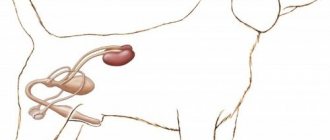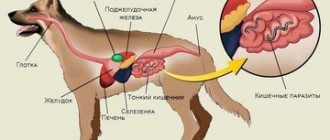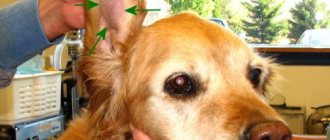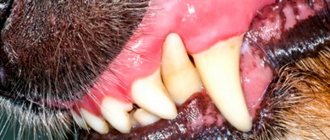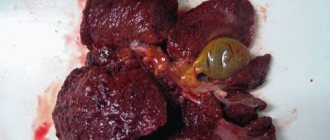Prostatitis in dogs is a common pathology; it occurs, as is clear, in males. The disease is serious and leads to suffering for the animal and great stress and trouble for the dog owner. In the article we will look at the features of this pathology and find out what are the causes and symptoms of prostatitis in dogs. Let's find out how to treat prostatitis and what can be done to prevent the disease.
Description and reasons
Prostatitis is an inflammatory process in the prostate gland. The disease occurs in dogs over the age of five years. The pathology is serious, dangerous, and can lead to serious consequences: that is why the disease requires mandatory diagnosis and urgent treatment. The symptoms of the disease can be confused with cystitis, so in this case only a veterinarian should make a diagnosis and prescribe treatment.
The immediate cause of the disease in a dog is a bacterial infection that has penetrated the genitourinary organs. Sometimes the cause of the disease is some autoimmune pathology, which is very difficult to diagnose and treat.
Theoretically, a dog of any age can get prostatitis, but dogs that are 5-7 years old are more likely to get sick. This pathology can be caused by many reasons, but more often these are pathological inflammatory processes in the pelvic organs, as well as hormonal disorders. Let's look at the main reasons that cause this disease in dogs.
These are various hormonal disorders in the body, or illiterate treatment of the dog with hormonal drugs, or exceeding the dose of such drugs.
Diseases of internal organs: colitis, urethritis, proctitis negatively affect the condition of the prostate in dogs. Pathologies of an infectious nature can also be the cause of the disease. If the dog was misdiagnosed and treated for a long time with the wrong medications, this fact can also cause the disease.
Lack of hygiene procedures, the dog being in the dirt, among garbage, rubbish and in similar unsanitary conditions. Sometimes individual predisposition plays a role.
If a dog is inactive, it is more susceptible to prostatitis. Low immunity is also one of the main reasons.
The disease leads to an increase in the volume of the animal's prostate gland. This fact leads to a slowdown in blood circulation and the creation of favorable conditions for the proliferation of bacteria.
Reasons for development
The causes of prostatitis in animals and humans are almost identical, but in dogs the main factor is hormonal imbalance. The main causative agents of the inflammatory process are mycoplasma and Escherichia coli; they penetrate the prostate from the outside, or are transported through the bloodstream from nearby organs.
Why does prostatitis occur:
- hormonal imbalance, long-term use of steroid medications;
- chronic urethritis, colitis, proctitis;
- groin injury;
- failure to comply with hygiene rules;
- physical inactivity;
- decreased immunity.
The predisposition to prostate enlargement is inherited; before purchasing a puppy, it is necessary to study the pedigree; pets must be regularly shown to the veterinarian, even at a young age.
Course of the disease and symptoms
Prostatitis in a male dog can be either acute or chronic. In the acute form, the disease manifests itself with the following symptoms:
- high temperature (up to +40 degrees);
- headache;
- nausea, vomiting;
- difficulty with bowel movements;
- loss of appetite;
- frequent urination with blood;
- difficulty urinating;
- severe pain;
- stiffness of the dog’s gait;
The animal may experience feverish conditions: permanent or temporary. The gait takes on “wooden” characteristics and the dog becomes inactive. Possibly indigestion in the form of constipation and diarrhea. A pet may lose a lot of weight during its illness. Sometimes the dog spends hours trying to perform the act of urination, but to no avail.
In addition to the above, a dog infected with this disease is likely to become infertile. That is, such a male cannot be used for breeding.
If you notice the listed symptoms in your dog, you need to take your pet to a veterinarian. The sooner the diagnosis is made and treatment begins, the more likely it will be to prevent possible complications of prostatitis. Note that although the acute form can be treated more quickly, it often leads to complications in the form of dangerous abscesses or even purulent peritonitis.
The chronic course of the disease does not have such pronounced symptoms. Most often, with a similar course of the disease, the dog periodically feels pain when urinating, but outwardly this fact does not manifest itself in any way and is invisible to the owner of the animal. In general, the dog’s condition is normal - the animal eats as usual, is quite active and cheerful. This lack of symptoms makes early detection of chronic prostatitis very difficult, which sometimes leads to serious consequences.
Chronic prostatitis in a dog can only be detected by examination by a veterinarian. Therefore, every pet owner should make it a habit to regularly examine their pet at the veterinary clinic, regardless of whether there are any alarming symptoms or not.
Symptoms and first signs of the disease
The tumor grows strongly and begins to compress the surrounding tissues, so the first signs and symptoms of the disease are the appearance of droplets of blood in the urine and difficulty urinating.
If the tumor becomes very large, the dog may experience discomfort and pain in the groin area. Because of this, the pet’s gait becomes awkward, the animal begins to drag its hind legs and limp.
Another sign of adenoma is frequent constipation. The tumor compresses not only the urethra, but also the rectum, making the passage of feces difficult. When emptying the intestines, the pet is worried, looks for a place for a long time, and may whine.
Diagnosis of prostatitis
When examining a dog, diagnosing prostatitis in some cases is quite difficult. Often this disease has symptoms similar to those of cystitis, urethritis, and tumor formations. The disease is diagnosed using the following methods:
- direct palpation of the prostate gland;
- study of biomaterials (potassium and urine);
- Ultrasound of the pelvis;
- examination of the prostate gland through the rectal opening;
The presence/absence of certain symptoms can also point the diagnosis in the right direction.
Since the symptoms of prostatitis are similar to those of many other diseases, additional examinations are sometimes required to make an accurate diagnosis. Prostatitis of the chronic type is especially difficult to diagnose; in this case, sometimes the dog even has to undergo a biopsy. Please note that the biopsy procedure is quite complex and dangerous, so it is performed only if there is no other way to correctly diagnose the dog’s condition.
In case of illness, it is important to diagnose this pathology in a timely manner. This way, treatment will be prescribed in a timely manner, which will save the reproductive and general health of the pet.
Necessary treatment of the prostate in a dog
It is important to begin treatment for prostatitis in dogs as early as possible. If you delay in starting therapy, the disease may progress into the chronic phase, when the symptoms will be less pronounced and the treatment itself will be more difficult. In the acute course of the disease, the dog, as a rule, feels very unwell, and its malaise is noticeable to the naked eye. Without proper care and treatment, the dog may even die.
Prostatitis is usually treated with antibiotics: the dog must take antibacterial drugs for three weeks. The drug is prescribed after examinations: the antibiotic drug must correspond to those pathogens that are directly “culpable” for the pathology of a particular dog. The most effective antibiotics for treating canine prostatitis are:
- clindamycin;
- trimethoprim;
- erythromycin;
- chloramphenicol.
In addition to the above, drugs from the group of quinolones and sulfonamides are also effective. If the case is severe and advanced, intravenous infusions of special nutrient solutions, as well as buffer (barrier) solutions, are used. These substances help eliminate or reduce the symptoms of intoxication.
In addition to antibiotics, non-steroidal anti-inflammatory drugs are used to quickly rid the dog of infection. However, long-term therapy with these drugs is prohibited, since they strongly damage the immune system. If there is a high temperature or pain, symptomatic treatment with appropriate antipyretic drugs and analgesics is prescribed.
Completion of treatment
When the course of treatment comes to an end, it will be necessary to take tests again to detect any remaining pathogens. If any are detected, the course of therapy will have to be extended. After the dog has fully recovered, a repeat control examination is scheduled six months after the end of treatment. If treatment with the prescribed drug does not produce results, the veterinarian prescribes another drug.
If, after two weeks of therapy, no significant improvement in the dog’s condition is noticed, and the level of leukocytes in the blood only increases, most often a decision is made to castrate the animal. This extreme measure allows you to avoid serious and sometimes fatal complications. Note that young dogs with prostatitis recover easier and faster than adult dogs. Young animals are rarely castrated; usually dogs over five years old undergo this operation.
If medical care was provided correctly and in a timely manner, then with acute prostatitis the dog recovers already on the 12th day of treatment. A mild form of the disease is treated at home, but a severe form is treated in a hospital.
Treating chronic prostatitis in dogs is more difficult than acute prostatitis. Sometimes it is even necessary to castrate the animal if the chronic course of the disease leads to complications. Chronic prostatitis leads to rupture of the prostate abscess; in this case, surgical intervention is required urgently. Even the most experienced surgeon cannot guarantee a positive treatment outcome.
If the case is not very severe, and the dog was sent for home treatment, you should see a veterinarian every week or two. This measure will help to adjust treatment in time. If prostatitis is chronic, then the dog should be under veterinary control for at least a month: this will help prevent relapses and complications of the disease.
Pay attention to the color of the dog's urine: the lighter the liquid becomes, the better the animal's condition becomes. When the urine becomes clear and light, as before the disease, we can talk about the animal’s complete recovery.
Advice for dog owners - Prostate diseases in male dogs
Dear dog owners!
According to statistics, 60% of uncastrated males over 5 years old and 100% of uncastrated males older than 10-12 years have prostate hyperplasia. Timely castration of male dogs not used for reproduction prevents age-related prostate hypertrophy. Among the diseases of the prostate gland there are: - acute and chronic prostatitis - benign prostatic hyperplasia - squamous metaplasia of the prostate - prostate abscess - prostate cysts - neoplasia. The main clinical symptoms of prostate diseases: - urinary disorders: increased frequency of urination, urination in small portions, drops, urinary incontinence, blood in the urine (not only during urination, but also during periods of rest), recurrent urinary tract infections, urinary retention up to until complete obstruction; - systemic symptoms: chronic hyperthermia (increased body temperature), periods of acute fever, collapse, shock in the terminal stage of the disease; - motor dysfunction: deep pain and discomfort in the pelvic area, pain in the lower spine, weakness or paresis of the pelvic limbs, pain in long bones with metastases, septic arthritis, swelling of the pelvic limbs; - gastrointestinal symptoms (not always observed, but sometimes are the only symptoms): frequent urge to defecate (tenesmus), constipation, thin ribbon-like feces, one- or two-sided rectal diverticulum often forms with stagnation of feces and difficulties in defecation up to inability to empty the rectum; - sexual dysfunction: infertility, inability to mate or ejaculate. To diagnose prostate diseases, both laboratory (urinalysis, semen, blood tests) and visual methods (radiography, urography, ultrasound) are used. A clinical examination allows you to assess the size, pain, symmetry, homogeneity of the prostate and its position relative to surrounding tissues and organs, and the presence of associated symptoms. Treatment. Prostate hyperplasia in dogs over 5-7 years of age is considered normal if it is not accompanied by clinical symptoms. Castration is considered the most effective method for correcting the manifestations of prostate hyperplasia, after which prostatomegaly usually disappears within the first week. In addition, progestogens, antiandrogen drugs, 5-alpha reductase inhibitors, GnRH agonists or antagonists are prescribed. Covinan is convenient to use due to its prolonged action and relative safety. But in terms of effectiveness, conservative intervention is significantly inferior to surgical castration and is relevant mainly for stud dogs who need to preserve reproductive ability. The most controlled and noticeable effect with preservation of fertility is provided by 5-alpha reductase inhibitors (finasteride). Estrogens should be used very carefully, as they can provoke irreversible suppression of hematopoiesis and prostate metaplasia. For malignant changes in the prostate, neither surgical nor conservative intervention is effective. Treatment of prostatitis is most successful in the acute phase due to the permeability of the blood-prostatic barrier. The course of antibiotic therapy should be quite long (at least 4-6 weeks). If a dog has a persistent prostate infection, antibiotics must be used for the rest of his life to prevent the pathogen from entering the urinary tract. Among the antibiotics, fat-soluble drugs are preferable - fluoroquinolones (baytril, norbactin, enrofloxacin), trimethoprim sulfa, tetracycline, chloramphenicol. In difficult cases, an antibiotic is selected based on the sensitivity of the microflora. Chronic prostatitis is less treatable due to the activity of the blood-prostatic barrier, deterioration of blood supply and the development of tissue fibrosis. In some cases, prostate cysts and abscesses are treated primarily surgically by draining the cavities and castration. Prostaectomy (removal of the prostate gland in veterinary medicine is not justified due to the high risk. The main treatment is supplemented by symptomatic treatment - antispasmodics (baralgetas, spazgan) with an analgesic effect; in an acute condition with severe swelling of the prostate, a novocaine blockade with an antibiotic and a steroid subrectally above the base of the penis is advisable. With concomitant defecation disorders, measures are necessary to promote rectal emptying, possibly with surgical correction of rectal diverticulum.Acute bacterial prostatitis occurs with severe intoxication, up to sepsis and shock, and requires intensive detoxification therapy (drip infusions, antishock agents. Should be carefully monitored urine outflow, catheterization or cystocentesis is performed if necessary. In uncomplicated cases of prostatomegaly, homeopathic medicines for the correction of prostate hyperplasia (adenoma), herbal medicines (Tykveol, Peponen, Trianol, Prostamol Uno, Urtiron) may be useful. . For acute disorders of urination or defecation, you can use Vitaprost suppositories and drugs that reduce dysuric phenomena (dalfaz, omnic). Alpha-blockers are not always well tolerated; they are used when all other measures are ineffective and under the strict supervision of a doctor. Possible consequences of bacterial prostatitis include orchitis, epididymitis and infertility. Prostate cysts and neoplasms rarely lead to reproductive dysfunction. You can obtain detailed information on the issues of breeding dogs and cats and diseases of the reproductive system from the books of the Sofion publishing house “Guide to the reproduction and neonatology of dogs and cats” and “Endocrinology and reproduction of dogs and cats.”
Disease prevention
To prevent the dog from developing prostatitis, it is important to promptly treat all diseases of the genitourinary system that arise. Prostatitis often appears as a complication of an inflammatory process that was undertreated or ignored at the time.
You should regularly walk your dog outdoors - in any weather. Walking strengthens the dog, makes its immunity stronger, and activates the work of all internal organs.
Mate the male according to plan. Uncontrolled mating with different “partners” leads to the appearance of various infections of the genitourinary system. It is also important to maintain proper cleanliness of the animal’s genitals: wash the dog more often if it does not want to take care of its hygiene.
It is important to adjust the animal’s diet: the dog’s menu should include all the substances its body needs. If you cannot provide such nutrition yourself, it is better to use ready-made food, where all minerals and vitamins are taken into account.
If a male dog has a tendency to prostatitis, sometimes it is more profitable to castrate him. The same measure will ease the dog’s fate during regular matings. Have your dog checked by a veterinarian periodically. Early diagnosis will help cope with prostatitis faster and easier.
We learned why prostatitis is dangerous for a dog, and how this disease should be treated. Prostatitis can lead to quite serious complications, so treatment of the animal must begin immediately after diagnosis. Timely measures taken will allow you to get rid of the disease in a relatively short period of time and keep your pet healthy.
Source realpet.ru
Inflammation of the prostate gland - prostatitis, is quite common in dogs over the age of 5 years. Like all serious diseases, prostatitis requires urgent examination and treatment. Its symptoms can be confused with cystitis in dogs, so a specialist should diagnose and prescribe treatment.
Causes of prostatitis
There are many causes of prostatitis. For example, infections of the genitourinary system, hormonal imbalance (androgens and estrogens), anatomical features of each individual, neoplasms and neoplasia, trauma. According to statistics, 100% of male dogs who have not been neutered will in any case encounter one or another prostate disease.
Nature of the disease
The prostate gland is located in the area of the bladder neck and urogenital canal.
- ejaculate production;
- closing the opening of the bladder during ejaculation.
The prostate gland in dogs has a round shape and a lobular structure. The process of producing ejaculate in the body of a healthy animal occurs constantly. The secretion is excreted not only during ejaculation, but also along with urine during urination.
Inflammation of the prostate gland can indicate a number of diseases, so it is not easy to diagnose.
Diseases accompanied by or causing inflammation of the prostate gland:
- paraprostatic cysts;
- benign prostatic hyperplasia;
- purulent prostate abscess;
- neoplasms in the prostate area;
- prostate metaplasia.
They can cause prostatitis in a dog or accompany it, complicating the course of the disease.
Differences between a malignant tumor and a benign one
The main difference between a malignant prostate tumor and a benign one is its rapid growth. Dogs are diagnosed with prostate adenocarcinoma. Such a tumor grows rapidly, metastases spread with lymph and affect the bladder, pelvic muscles, and colon.
With adenocarcinoma, the pet experiences pain when moving, which does not happen with adenoma. Other symptoms of oncology that distinguish it from a benign neoplasm include exhaustion of the animal, fever, depression and refusal to eat.
Causes
Prostatitis is a disease that occurs in dogs of any age, but more often it appears after reaching 7 years of age. It is often caused by pathological processes in organs located near the prostate gland and hormonal imbalances.
Causes of prostatitis in dogs:
- hormonal disorders, uncontrolled treatment with hormonal drugs;
- diseases of other internal organs: proctitis, urethritis or colitis;
- infectious pathologies;
- bacterial infections;
- long-term improper treatment of various diseases;
- penile injury;
- lack of hygiene of the dog’s genital organ;
- predisposition;
- lack of physical activity;
- reduced immunity.
The consequence of prostatitis is an enlargement of the prostate gland beyond normal. Because of this, blood circulation in the tissues of the organ slows down, and favorable conditions for the proliferation of microbes develop.
Is there anything in common?
Often on the Internet you can find a description of “human” prostatitis, converted to “canine”; It is difficult for people who understand little about animal diseases to understand where the real description of the pathology is and where it is pure fiction. That is why, before starting to treat your pet yourself, it would be right to show the dog to a veterinarian so that the diagnosis can be made reliably.
You should not adjust the signs of prostatitis in a man to the symptoms of an unidentified disease in animals, and antibiotics prescribed outside of the established diagnosis will be completely unnecessary.
What can a person have in common with prostatitis and the disease in dogs? Practically nothing, but the following signs indicate the occurrence of prostatitis in dogs: intermittent urination, frequent urges, pain in the area of the penis and scrotum. In reality, the disease itself is more of a collective image, differing from prostatitis in men in the following ways:
- There are no gradations by age; unlike men, dogs can have prostatitis at any age (from 6 months to old age).
- The cold factor as a cause of prostatitis in males has not been confirmed.
- The effect of infection also remains in doubt; although pathogenic microorganisms can negatively affect the dog’s genitourinary system as a whole, it is not a fact whether prostatitis will be the result.
Therefore, it turns out that the symptoms that some sources attribute to prostatitis in dogs have nothing to do with the real state of affairs. The reasons for the development of the disease are also different.
What reason for the appearance of prostatitis in male dogs is considered today the most plausible and resistant to criticism? Experts tend to support the version of an imbalance of sex hormones; it is for this reason that a modified prostate gland is formed, increases in size, with subsequent disruption of blood supply and the development of accompanying symptoms. However, typical “human” factors should also not be discounted; if dogs are not properly maintained, the inflammatory process, hypothermia and other reasons create a favorable field for the development of pathogenic microflora.
Forms of the disease and their symptoms
Like all diseases, prostatitis in dogs can occur in two forms: chronic and acute.
The acute form is characterized by a sharp deterioration in the animal's health. The following symptoms appear:
- temperature increase up to 40 °C;
- headache;
- nausea and vomiting;
- loss of appetite;
- difficulty defecating;
- discharge of blood from the urethra;
- severe pain that limits movement;
- frequent urination at night or during the day;
- infertility;
- lack of urination.
In case of acute prostatitis, it is necessary to show the dog to a veterinarian for diagnosis and treatment.
Chronic prostatitis does not have pronounced symptoms. Sometimes the dog may feel slight pain when urinating, but this is not noticeable outwardly. Otherwise, the male's condition is satisfactory, nutrition and mood remain normal.
Chronic prostatitis is dangerous because it is very difficult to detect in the early stages. It can only be diagnosed through systematic examinations by a veterinarian and tests.
Diagnostic methods
It is impossible to independently diagnose prostatitis in dogs without appropriate education. Therefore, if you have symptoms indicating a possible disease, you should contact a veterinary clinic, where a diagnosis will be made based on a rectal examination and laboratory tests.
Diagnosis of prostatitis consists of a comprehensive study of physiological indicators and is not limited to laboratory tests.
Main types of research:
- general urine analysis;
- examination of urethral swabs;
- antibiogram;
- biochemical and clinical blood tests;
- Ultrasound examination of the genitourinary system.
Diagnostics
Diagnosis of a chronic disease is difficult due to the lack of alarming symptoms. To make an accurate diagnosis, it is necessary to exclude other diseases in the dog: cystitis, tumors, and so on.
Methods for diagnosing chronic and acute prostatitis:
- palpation of the prostate gland;
- urine and blood analysis;
- ultrasonography;
- rectal examination of the gland;
- symptom analysis.
Proper diagnosis and prescribed treatment are the key to a speedy recovery for your pet.
How is prostatitis diagnosed?
The world is developing rapidly, and veterinary medicine is not lagging behind. Modern Aibolits are armed with the following methods for diagnosing prostate diseases:
- History (information about the pet and the owner’s story about what is bothering him);
- Rectal examination;
- Urine analysis and culture;
- Blood tests (general and biochemistry);
- Cytological examination of discharge from the prepuce and prostate secretions;
- Ultrasound of the genitourinary system;
- MRI and CT;
- X-ray examination;
- Gland biopsy.
There are many studies, but all of them are necessary for an accurate diagnosis. A correct diagnosis is the key to correct treatment!
Dog treatment
If left untreated, the acute form of prostatitis becomes chronic, so you need to take action as early as possible.
Typically, a veterinarian will prescribe a course of antibiotic therapy for a male dog for 3 weeks.
The drug is prescribed based on test results - depending on which pathogenic organisms caused the inflammatory process.
If there are accompanying symptoms, the dog is prescribed treatment with hormonal, antipyretic and painkillers.
At the end of the course of treatment it is necessary to take tests again. Based on their results, a decision will be made to discontinue or continue therapy.
After the dog has recovered, a re-examination should be carried out no later than six months later. If necessary, another drug is prescribed.
Chronic prostatitis is much more difficult to treat than acute prostatitis. If relapses are frequent, your veterinarian may suggest neutering your dog. The advisability of such a measure should be discussed with a veterinarian in each individual case.
When diagnosing a ruptured gland abscess, urgent surgery is necessary, but no one can give guarantees of success.
Treatment of acute prostatitis in dogs leads to recovery already on the 12th day with proper care.
The initial stage of the disease can be treated at home under the supervision of a veterinarian, but in more complex cases, therapy is carried out in the clinic.
Prevention of prostatitis
To prevent the development of prostatitis in a male dog, you need to remember the rule: all diseases of the genitourinary system are best treated as early as possible, before they lead to more serious complications.
Measures to prevent prostatitis:
- timely treatment of all diseases;
- regular walks in the fresh air;
- planned matings;
- maintaining hygiene of the dog’s genital organs;
- good nutrition;
- castration of male dogs with a predisposition to prostatitis, or in the absence of the opportunity to carry out regular matings.
Preventive examinations of your dog will help you detect and eliminate the problem in time, so visit your veterinarian at least once every six months.
If one or more alarming symptoms of prostatitis appear, it is better to consult a doctor immediately. This will help keep the animal not only healthy, but also alive.
Source veterinargid.ru
Prostatitis is the nightmare of all men over 40... Although, one should not assume that this disease is unique to humans. Inflammation of the prostate in dogs also occurs, and also leads to quite severe results.
Causes of development of prostate adenoma in dogs
Veterinarians identify several reasons for the development of prostate adenoma in dogs:
- Hormonal disorders. The development of the disease is provoked by hormonal imbalance: the level of testosterone (male hormones) decreases, and estrogen (female hormones) increases.
- Heredity. There is a version that the predisposition to prostate adenoma is inherited.
Another possible reason for the development of pathology is the lack of regular mating. In this case, there is a risk of degeneration of a benign tumor into a malignant one.
What it is?
This is called inflammation of the prostate gland. As a rule, the pathology is of bacterial origin. Simply put, with this disease an inflammatory process occurs in the prostate gland. Sometimes the disease is a consequence of inflammation of the urethra, as well as the bladder. These cases are the most typical, they occur most often. But prostatitis may well be a consequence of much more serious pathologies. Such as pyelonephritis, for example. In 87% of cases, inflammation of the prostate occurs in non-castrated males aged seven to eight years. The older the dog, the higher the risk of disease. Pathology can be either acute or chronic. The acute form is more dangerous, as it often leads to the development of abscesses and can result in purulent peritonitis.
What symptoms indicate the onset of the disease? They are quite diverse, and the clinical picture can vary greatly depending on the form of the disease (acute, as we have already mentioned, is much more severe). In typical cases, the following occurs:
- Fever of a constant or intermittent type.
- Bloody or cloudy discharge from the penis.
- Red colored urine (hematuria).
- Diarrhea, constipation.
- "Wooden" gait.
- Weakness, complete or partial refusal to feed, weight loss.
- Lethargy.
- The dog strains strongly when urinating or defecating. At times, your pet may spend hours trying to empty its bowels or bladder without much effect.
- In the case of chronic prostatitis - infertility of the male dog, inability to perform mating.
Types of prostate diseases
Currently, veterinary medicine knows the following diseases of the prostate gland (from more to less common):
- Benign hypertrophy and hyperplasia;
- Acute and chronic prostatitis;
- Squamous metaplasia;
- Prostate abscess;
- Paraprostatic cysts;
- Neoplasms and neoplasia.
It would seem that a small gland, but how many different diseases there can be. It’s not for nothing that people say: “The spool is small, but expensive.”
Diagnosis of prostate inflammation
If you notice at least one of the above symptoms, immediately take your pet to the veterinarian.
Your veterinarian will need to perform the following types of diagnostic tests to determine the presence or absence of inflammation in your dog's prostate:
- Palpation of the prostate gland through the wall of the rectum.
- Analysis of urine.
- Sowing the resulting pathological material onto nutrient media.
- Microscopic examination of prostate secretion.
- X-ray of the pelvic and abdominal cavities.
- Ultrasonography.
- Blood test, assessment of ESR and biochemistry.
Prevention
The main method of preventing prostatitis is timely detection and treatment of any pathologies of the genitourinary system.
How to avoid problems with the prostate gland - veterinarian recommendations:
- walk your dog more in the fresh air;
- plan to breed a male;
- wash the animal’s genitals daily;
- Feed your dog only healthy food; there are special preventive foods:
- Visit your veterinarian for preventive examinations every 6 months.
If you have a predisposition to prostate pathologies and are unable to breed animals regularly, doctors recommend castration.
Prostatitis is often diagnosed in older dogs, but the pathology is often diagnosed in puppies. The disease causes severe discomfort to the animal, requires long-term treatment; in case of a chronic course of the disease, doctors recommend sterilizing the animal. Timely diagnosis and adherence to simple rules of prevention will help protect your pet from the occurrence of an inflammatory process in the prostate gland.
Differential diagnosis
The problem is that all of the clinical signs described above may well be caused by diseases that have nothing to do with prostatitis. All of them can appear either separately or together with inflammation of the prostate, and their causes are often the same. Moreover, inflammation of the prostate gland in dogs is often a consequence of one of these ailments.
Prostate abscess. It is characterized by the formation of a cavity in the thickness of the organ containing leukocytes, bacteria and cell decay products. Most often, the pathology is a consequence of chronic diseases of the genitourinary system. An abscess not only causes a severe pain reaction, depriving the animal of sleep and rest. It always shows a tendency to increase. In some cases, such ulcers can reach the size of a large orange. It is not surprising that they are capable of completely compressing both the rectum and the urethra. Because of this, your pet will strain very hard when urinating and defecating.
Benign prostatic hyperplasia (BPH) . This pathology is very easy to confuse with prostatitis, since with this disease the size of the prostate also greatly increases. Again, the disease affects old dogs, which leads to simple consequences - many cases of “chronic prostatitis” are actually hyperplasia. It develops against the background of hormonal disorders, common in the body of old pets. As a rule, benign tissue growth does not give any obvious clinical signs. Sometimes hematuria may develop. It can only be diagnosed by X-ray or ultrasound examination of the abdominal cavity.
Prostatic neoplasia (cancer) also “imitates” chronic prostatitis. Unlike benign tumors, malignant tumors immediately affect the health of the animal: the dog becomes lethargic, refuses food, and quickly loses weight. It is not by chance that we identify malignant neoplasms, since prostate neoplasia is cancer in 89% of cases. The most common types of cancer are adenocarcinoma and transitional cell carcinoma. It is interesting that oncology occurs with equal frequency in both castrated and “manly” male dogs.
Squamous metaplasia. This pathology develops against the background of hormonal disorders associated with excessively active secretion of estrogen. In turn, the main cause is a testicular tumor that appears from Sertoli cells. In some cases, this effect may be due to long-term use of hormonal drugs. Interestingly, Sertoli cell tumors have an extremely bad effect on the red bone marrow, which is why the animal often develops chronic anemia.
Thus, to obtain an accurate diagnosis, it is necessary to combine a detailed physical examination with diagnostic tests. Even the “characteristic” clinical picture does not always indicate inflammation of the prostate. So, an intact male dog (not neutered) with a fever, abdominal pain, blood or pus in the urine is unlikely to have prostatitis. Rather, he suffers from pancreatitis. Dogs with prostate inflammation are usually lethargic and painful, but signs of acute inflammation do not always appear. Chronic prostatitis is even more difficult to diagnose.
In doubtful cases (and they are almost always like this), a biopsy will have to be done in order to accurately determine from the state of the tissue the condition of the pet’s prostate. The procedure is quite dangerous and is recommended only when necessary. In addition, to perform a biopsy, the animal must be given general anesthesia. The only “characteristic” sign of chronic prostatitis is the absence of pain during rectal examination of the prostate . Accordingly, the prognosis and further therapy largely depend on the stage of development and form of the disease.
Other prostate diseases in dogs
Prostate diseases that have similar symptoms include:
- Prostate abscess
is an isolated “pocket” formed within the prostate gland, containing white blood cells, bacteria and cell breakdown products. Abscesses can form due to chronic infection and can become large and cause compression of the colon and urethra. Animals experience painful tenesmus when they defecate or urinate. The general condition of a sick dog is usually unsatisfactory; - Benign prostatic hyperplasia (BPH)
- BPH is the most common form of prostatomegaly (increase in the size of the prostate gland), occurring in almost all older, uncastrated male dogs, which is caused by an increase in the number and size of prostate cells under the influence of normal hormonal levels; - Prostate cysts;
- neoplasia (prostate cancer).
Prostatic neoplasia may clinically mimic chronic prostatitis, although animals with prostate neoplasms typically have systemic deterioration in health and a history of weight loss. Prostate tumors are almost always malignant, the most common types of tumors being adenocarcinomas and transitional cell carcinomas. Unlike most other prostate diseases, prostate cancer occurs in intact and neutered dogs at approximately the same frequency. In neutered male dogs with significant prostatomegaly, prostate neoplasms should be considered as the main possible diagnosis. Prostate biopsy allows to differentiate chronic prostatitis from neoplasia; - Squamous cell metaplasia of the prostate
is a change in the prostate gland due to increased levels of estrogen in the blood. The main cause of squamous metaplasia is estrogen-producing tumors (sertoliomas).
Possible reasons
As practicing veterinarians today assume, the main cause of inflammation of the prostate is some kind of bacterial infection that affects the genitourinary system. Pathologies of the bladder and kidneys are especially dangerous However, cases of prostatitis after illnesses accompanied by symptoms of sepsis have been repeatedly described. E. coli (more precisely, its pathogenic strains) is the most common bacterium that causes infection.
As with any inflammatory disease, the predisposing factors are quite typical - weakened immunity due to chronic stress, poor nutrition, helminthic infestations, etc. In addition, in rare cases, some congenital pathologies of the development of the prostate, as well as autoimmune diseases, can lead to the development of pathology. The latter are the most difficult to deal with, since they are very difficult to identify and can be completely impossible to cure. There are quite rare cases where the prostate in dogs became inflamed due to poisoning by mold toxins and pathogenic fungi. However, inflammatory diseases of “moldy” etiology are far from uncommon in dogs whose owners save in every possible way on feeding their pet.
Prevention of prostatitis in dogs
Effective methods for preventing prostatitis in dogs are:
- castration of males not participating in breeding;
- timely treatment of infectious diseases of the genitourinary system;
- Regularly walking your pet to empty its bladder and bowels.
It is also necessary to provide the dog with a complete diet, balanced in the content of vitamins and minerals, which will provide a high level of immunity and minimize the risk of developing hormonal pathologies and obesity.
Source vashipitomcy.ru
Over the last 60 days, 2 issues (1-2 times every 2 months)
Statistics
Therapeutic techniques
Treatment, as we have already said, depends on the form of the disease and the degree of neglect of the pathological process. Thus, with acute prostatitis, the animal, as a rule, feels unwell, and in the absence of the most basic care, it may even die from septic phenomena. To prevent this, tests are taken from the animal, including through a massage through the rectum, the contents of the prostate are taken, and then antibiotic therapy is prescribed. When a culture of the pathogen is grown from the selected pathological material, the current therapy can be adjusted by selecting the most effective drugs.
Of course, starting antibiotic therapy without first identifying the causative agent is not the best idea, but in this case there may be no choice, since delay can be fraught with the development of a prostate abscess and other “troubles.” Here is a list of the most effective antibiotics for prostatitis: erythomycin, clindamycin, chloramphenicol, trimethoprim. Sulfonamides and quinolones are quite effective.
Antibiotics are usually given for a minimum of four weeks; in complex cases, the treatment period can be significantly extended. In advanced cases, when the general condition of the animal is very serious, intravenous infusions of nutrients and buffer compounds are also prescribed to relieve intoxication. In addition, painkillers may need to be administered.
If no improvement in the animal’s condition is visible within two weeks, and blood tests constantly show a significantly increased level of leukocytes, it is strongly recommended to castrate the dog , since its reproductive function after such a serious illness will be in question in any case. However, such a radical approach is more recommended for pets aged five years and older. In young animals, prostatitis can most often be managed within a week or two (maximum).
It is known that after castration, the size of the prostate gland decreases by about half in three weeks. It is believed that it reaches normal values in about two to three months. This effect is associated with a gradual decrease in the level of male sex hormones in the blood. Studies conducted by veterinarians also prove that when male dogs are castrated before they reach puberty, the likelihood of developing prostatitis is reduced by at least 70%. In cases where the animal is not of breeding value, you can think about this in advance - this way the dog will be calmer and his health will be stronger. But castration, by the way, has no effect on the likelihood of prostate cancer.
What else can be done to improve the pet's condition? Non-steroidal anti-inflammatory drugs may also be prescribed to relieve the inflammatory reaction . True, it will still not be possible to treat the dog with them for too long: these drugs “with a bang” strain the immune system, which is fraught not only with the deterioration of an existing pathological process, but also with the appearance of new “sores”. In particular, there is a far from illusory danger of developing fungal skin pathologies in a male dog.
Home care and prevention
Every one to two weeks after starting treatment, it is imperative to show your pet to a veterinarian. At the same time, blood tests are taken again to assess the dynamics. In principle, it is better to take urine and samples of prostate secretions every three to five days, especially in complex cases: this way the specialist can understand whether the therapy is giving a positive result. You may need to treat your dog's prostate inflammation further.
Important! Constantly monitor how and “what” your dog urinates with - if the color of the urine gradually becomes lighter and the liquid itself becomes clearer, the pet is probably on the mend. Please note that when treating chronic prostatitis, the animal must be under the supervision of a veterinarian for at least a month, since in this case the risk of relapse is quite high. If anything worries you, or you think that clinical signs are reappearing, immediately notify your healthcare professional.
In addition, for about five weeks after the end of treatment, it is necessary to take samples of blood and prostate secretions in order to accurately determine whether the pathogen remains in the dog’s body, and whether the inflammatory process has “started” again.
Source vashipitomcy.ru
Disease prevention measures
The basics of preventive measures are an appropriate lifestyle, proper diet, regimen, sufficient activity and timely detection of pathologies.
Veterinarian recommendations for preventing prostate problems in dogs:
- Maintaining hygiene of the external organs of the genitourinary system.
- Prevention of obesity and maintaining the animal’s physical activity.
- Avoid severe hypothermia; hunting dogs are more susceptible to this.
- Observance of planned matings and the intactness of the pet can provoke prostatitis.
- Provide conditions for defecation and urination according to the animal’s needs, so as not to force the pet to endure for a long time.
- Preventive examinations by a veterinarian at least once every six months.
If there is a predisposition and if the animal does not participate in breeding, and also if the dog has reached the age of 5–7 years, castration will serve as a prevention of prostate diseases.
Inflammation of the prostate gland is easier to prevent than to achieve a complete cure. Only strict adherence to prescriptions and timely administration of medications will ensure a complete recovery for the pet without residual pathologies of the genitourinary system.

